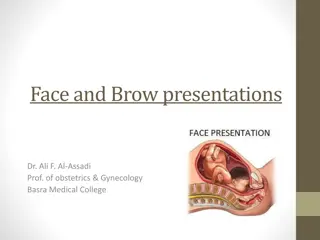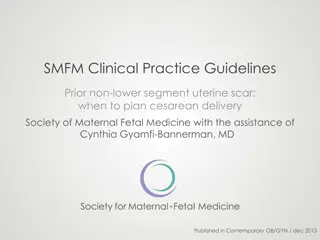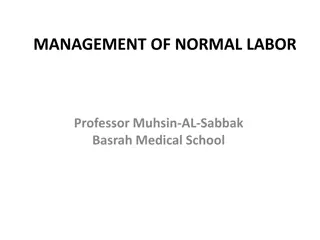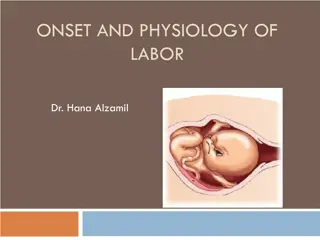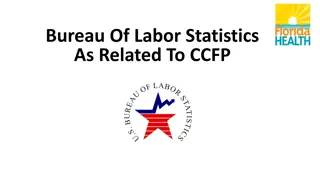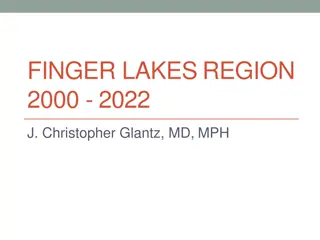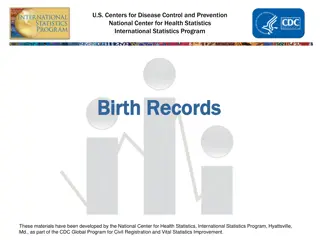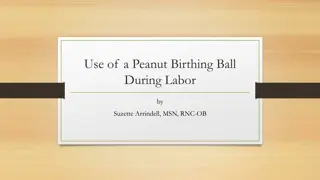Understanding the Trends and Factors Behind Labor Inductions and Cesarean Births
Analyzing the data presented, the content explores the prevalence of labor inductions, reasons for medical interventions during childbirth, and factors contributing to primary and repeat cesarean births. It delves into statistics from the US between 1990-2013, shedding light on the increasing rates of medically induced labors and cesarean deliveries. The information reveals various considerations and concerns healthcare providers and mothers have when making decisions related to childbirth, including the size of the baby and maternal health conditions. The content raises questions about the potential impacts of these trends on birth experiences and outcomes.
Download Presentation

Please find below an Image/Link to download the presentation.
The content on the website is provided AS IS for your information and personal use only. It may not be sold, licensed, or shared on other websites without obtaining consent from the author. Download presentation by click this link. If you encounter any issues during the download, it is possible that the publisher has removed the file from their server.
E N D
Presentation Transcript
Is there a problem with too many big babies? Birth by the Numbers Gene Declercq March, 2016
Labor Induction Three in ten (29%) mothers tried to start their labor on their own. More than four out of ten respondents (41%) indicated that their care provider tried to induce their labor Three out of four of those women (74%) indicating that it did start labor, resulting in an overall rate of medically induced labor of 30%. BirthByTheNumbers.org
Inductions in Vaginal Births, U.S., 1990-2013 30% 25% 20% 15% 10% 5% 1990 1992 1994 1996 1998 2000 2002 2004 2006 2008 2010 2012 Source: Centers for Disease Control and Prevention. National Center for Health Statistics. VitalStats. http://www.cdc.gov/nchs/vitalstats.htm. BirthByTheNumbers.org
Reasons why mothers experienced medical induction (choose all that apply) Base: care provider tried to induce labor n=991 44% Baby was full term/close to due date 19% Mother wanted to get pregnancy over with 18% Care provider was concerned that mother was overdue 18% Maternal health problem that required quick delivery Care provider was concerned about the size of the baby 16% 12% Water had broken and there was a concern about infection 11% Mother wanted to control timing of birth for work or other personal reasons 11% Care provider was concerned that amniotic fluid around the baby was low 10% Care provider was concerned that baby was not doing well 10% Mother wanted to give birth with a specific provider 10% Some other reason BirthByTheNumbers.org
Reasons for primary and repeat cesarean birth Primary cesarean n=368 n.a. Repeat cesarean n=376 61% Base: had cesarean n=744 (choose reason that best applies)) I had had a prior cesarean (asked of prior cesarean only) 16% 3% Baby was in the wrong position 11% 3% Fetal monitor showed the baby was having problems during labor 10% 13% I had a health condition that called for procedure 10% 2% Baby was having trouble fitting through Maternity care provider worried the baby was too big 9% 2% Provider tried to induce labor but it didn t work 8% 3% 8% 2% Problem with the placenta 7% 2% Labor was taking too long Past my due date 3% - Afraid to labor and have baby vaginally 3% - No medical reason 4% 3% So are babies getting bigger? BirthByTheNumbers.org
Are U.S. Babies Getting Bigger?...NO! % Singleton, Full Term Babies by Birthweight, U. S., 1990-2014 3500-3999gms 4000+gms 39% 50% 44% 44% 41% 39% 38% 40% 30% 30% 32% 30% 29% 30% 32% 20% 10% 12% 11% 9% 9% 12% 9% 0% 1990 1995 2000 2005 2010 2014 www.BirthByTheNumbers.org Source: Centers for Disease Control and Prevention. National Center for Health Statistics. VitalStats. http://www.cdc.gov/nchs/vitalstats.htm. (Access 12/23/15)
Whats with these Big Babies? What s with these Big Babies? Near the end of your pregnancy, did your maternity care provider tell you that your baby might be getting quite large? 31.9% YES ALL Yes No Actual Weight 7 lbs 5 ounces 7 lbs 7 lbs 1 ounce 14 ounces Baby Actually Macrosomic 9.9% 19.7% 5.5% (8lb 13ounces) Source: Cheng et al. Healthcare Utilization of Mothers with Suspected Large Babies. MCH Journal. 2015. 19:2578 2586
Labor and Delivery Outcomes Labor and Delivery Outcomes Suspected Large Baby Yes % Tried Self Induction of Labor Medical Induction of Labor Cesarean Delivery Epidural Analgesia Requested Cesarean Delivery No % 24.7 51.1 18.1 61.7 43.0 70.1 21.1 72.7 *** *** NS *** 32.5 6.8 *** 8 BirthByTheNumbers.org Source: Cheng et al. MCH Journal. 2015. 19:2578 2586
Likelihood of Labor or Delivery Outcomes Likelihood of Labor or Delivery Outcomes Controlling for Key Variables Controlling for Key Variables Self Induced Labor almost twice as likely Medical Induction almost twice as likely Epidural twice as likely Requesting a cesarean 4 times as likely 9 BirthByTheNumbers.org
So whats the lesson here? Language matters it may seem prudent to alert mothers to the possibility of big baby, but: A. The prediction appears strongly related to the mother s characteristics B. Most of the time the prediction is inaccurate C. It appears to change the way mothers look at their ability to give birth vaginally. BirthByTheNumbers.org
www.birthbythenumbers.org Follow Birth by the Numbers on Social Media: RSS (blog): www.birthbythenumbers.org www.facebook.com/BirthByTheNumbers Twitter: @BirthNumbers Email: birthbynumbers@gmail.com Birth by the Numbers on Pinterest








